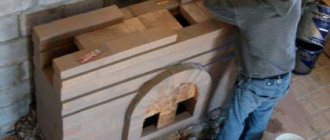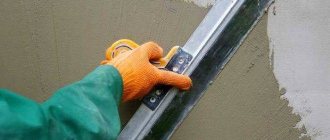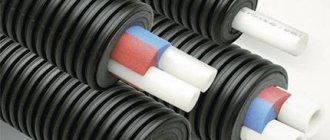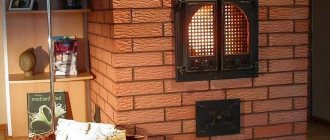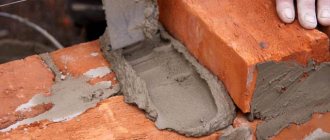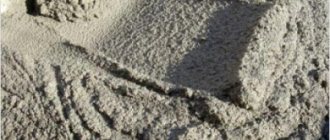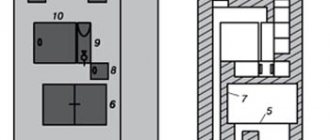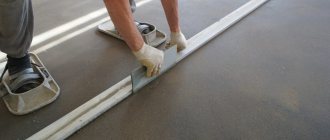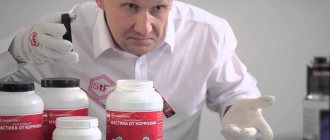When planning to build a fireplace or brick stove with your own hands, you need to choose the right materials. And we are talking not only about bricks, but also about the mixture for laying stoves. The correct choice of materials affects the properties of the finished product.
Mixture for masonry stoves
Modern craftsmen use different mixtures for laying stoves; to lay bricks with your own hands, you can choose a composition based on different bases. Compositions used:
- Cement;
- Mixed, consisting of several binding elements;
- Gypsum mixtures;
- Calcareous.
For masonry and cladding, as a rule, binders of mineral origin are used:
- Clay;
- Lime;
- Gypsum;
- Cement.
Fireproof mixtures for stoves and fireplaces are divided into several types:
- Clay , used for laying the main structural elements;
- Cement , used in the manufacture of foundations in wet soil. Used in the manufacture of external pipes. Used for preparing mixtures when installing chimneys above roof level.
Types of mixtures for laying fireplaces and stoves
Heat-resistant mortar is used for laying red brick.
Fireplace and stove structures are built from natural stone or refractory brick. To make the structure monolithic, various compositions are used. They are suitable for external masonry, firebox and chimney construction, pouring foundations, cladding and creating heat-resistant elements.
Based on the type of resistance to high temperature and fire, you can select a masonry stove mixture:
- heat-resistant – maintains the integrity and load-bearing strength of the structure at high temperatures;
- heat-resistant - protects the structural integrity of the masonry when exposed to fire and mechanical force;
- fireproof - the property of viscous products that are resistant to fire and the effects of combustion products.
The composition and proportions depend on the type of stove element.
Heat-resistant mixtures
Examples of heat-resistant dry mixtures for masonry stoves
The material is able to withstand heat, maintain the load-bearing capacity of the structure and not deform from high-temperature exposure. The standard mixture for pouring a monolithic firebox or erecting a frame is made on the basis of:
- 1 part of Portland cement grade M400-M600;
- 2 parts of ceramic crushed stone M150;
- 2 parts of fine quartz sand with fractions of 1 mm;
- 3/10 parts fireclay sand;
- water in the amount of 4 liters per 10 kg of mixture.
Purchased and self-prepared solutions are mixed in a concrete mixer - all ingredients are added gradually.
Finished materials are cleaned of organic matter, which eliminates the release of carbon monoxide during furnace operation.
Fireclay compositions
Crushed fireclay clay in a dry mixture for laying out the firebox.
A mixture based on refractory clay and quartz sand crushed to fine grain is characterized by:
- fire resistance depending on the manufacturer - from 1550 to 1850 degrees;
- average size of fractions from 2 mm
- moisture absorption - 2-10% for high-burnt fireclay, approximately 25% for low-burnt fireclay.
The fireclay product is supplied in 20 kg bags, which is enough for laying 20-30 bricks. The construction of the chimney and firebox is carried out from a clay-fireclay mixture in proportions 1:1. You will need ¼ of water.
On a note! Refractory clay is used for facing work, but only 4 weeks after the first fireplace fire.
Dry Potting Powder
Cement aluminate for preparing pouring mortar
Fire-resistant material based on cement aluminate and fireclay clay with fractions of 0.5 mm is used for pouring and repairing the internal parts of stoves, grills and fireplaces. Available in the form of a gray powder, scattered in 25 kg bags. Has the following properties:
- permissible minimum filling temperature - +5 degrees;
- hardening time - 1 hour;
- the yield of the finished mass is from 11 to 12 liters from a 25 kg bag;
- temperature resistance up to +1300 degrees.
The solution is mixed in a concrete mixer. You need to gradually add from 2.5 to 3.5 liters of water per bag. Large parts of the stove are poured with a layer of 50 mm, the roof - with a layer of 100 mm.
The refractory mass cannot be reinforced - its thermal expansion is less than that of metal.
Useful tips from the pros
Despite the fact that manufacturers of ready-made mixtures indicate the required amount of water, its volume also depends on the room temperature. At elevated room temperatures, a little more water is required, and at a low temperature (within normal limits, but not below +10 degrees) a little less. Experienced stove makers sometimes add table salt to the refractory mixture, which makes it possible to increase the strength of the seam. For 10 kg of dry composition, take 150 grams of salt. Instead of salt, you can add 1 kg of cement to the same volume of solution - grade M400 will be enough.
It is recommended to choose different compositions for the fireplace, due to the difference in their design and operation. The fireplace elements heat up less (in fact, only the combustion part is exposed to high temperatures), so increased heat resistance is not needed here, but strength and moisture resistance are important. In this regard, experts recommend diluting a lime-cement mortar for fireplaces, and a clay-fireclay composition for the firebox.
To learn how to prepare a mixture for laying bricks, see the following video.
Characteristics of oven mixtures
High-quality mixtures for stoves and fireplaces must have the following characteristics:
- heating limit from 1300 to 1780 degrees - heat-resistant material does not crack when exposed to high temperatures;
- finished density from 1000 to 1800 kg/m3 – allows you to form a durable layer with high thermal conductivity;
- frost resistance - up to 70 freezing and thawing cycles allows for external and internal construction;
- heat resistance, strength and ductility - properties increase the service life of the furnace;
- environmentally friendly - materials without volatile impurities and chemicals do not emit carbon monoxide during the fireplace combustion process;
- flammability class - a heat-resistant product is classified as NG (non-flammable);
- vapor permeability – from 0.09 mg/m*h*Pa – prevents molding of the seam.
A good composition during operation easily adheres to the surface, has a plastic structure and is easy to apply.
Advantages and disadvantages
You can quickly prepare a high-quality solution from a purchased mixture.
For laying stoves and fireplaces, a high-temperature mixture is used, which contains clay, sand, lime or cement, and heat-resistant ingredients. To obtain a homogeneous mass, water must be added to the material. Using finished products has several advantages:
- ease of mixing components;
- ready-made recipe that ensures the strength of the composition;
- versatility of use - suitable for cladding, laying external and internal parts;
- attractiveness and evenness of the masonry seam;
- availability of complete instructions with operating and mixing rules;
- ease of application and no risk of seam destruction.
The use of building materials is associated with some difficulties. The mass is mixed only with a mixer or in a concrete mixer, it hardens quickly, so it is prepared in portions.
Buy heat-resistant Terracotta mixtures - the best solution to hot problems
Our company offers to buy fire-resistant Terracotta mixtures . The materials are made from high-quality non-toxic raw materials and are easy and convenient to apply to surfaces. This guarantees an impeccable result of the work as a whole. Whether it’s laying heated floors, or constructing/repairing a fireplace, stove, barbecue, it will be much more pleasant and reliable to work using modern products. Various packaging options, high-quality packaging and proven recipes will ensure economical consumption and profitability of the purchase. A wide range of models will provide individual choice. For professionals, an important point is a favorable price range combined with excellent technical parameters and ease of use. Therefore, among similar products, the Terracotta company’s products in Russia, as well as abroad, are the undoubted leader.
Selection of mixtures for structural elements of the furnace
Fireproof fireclay mortar is necessary for laying the firebox and elements close to an open fire.
To select masonry materials, it is necessary to take into account that the stove consists of several elements:
- The foundation cushion is a monolithic element built separately from the foundation of the house.
- The base of the furnace is not subject to temperature stress, therefore it is built from solid red brick. Lime or lime-cement mortar is suitable for masonry.
- Fire blind area - represented by a sheet of asbestos or mineral cardboard, on which there is an iron sheet and felt impregnated with clay.
- The furnace mass - due to the increased impact of hot flue gas on the structure, is built from ceramic bricks with clay mortar.
- The firebox gets very hot, so it looks like a monolith on a fire-resistant clay-chamotte mortar.
- The beginning of the chimney is heated to +400 degrees, which requires laying on a mixture with a clay base.
- Otter, or fluff, is an element connecting the chimney and the ceiling. Temperature and aggressive effects on it are minimal, so a lime composition is suitable for standard bricks.
- Fireproof cutting is a heat-insulating metal box that does not require a solution.
- The chimney and fluff are exposed to wind and chemicals. Installed using red solution.
The correct choice of solution will save 10-12% of funds on the purchase of consumables.
Lime mixture
Lime mixture is used for laying outdoor stoves, as it does not absorb water.
The fireproof mixture for stoves consists of sand, lime paste (1 part quicklime + 3 parts water). To prepare it yourself, you will need to sift the sand, mix it with the dough in a ratio of 1:3 and add water until the sour cream becomes thick.
The heat resistance of the product is from 450 to 500 degrees, but it is non-hygroscopic. The product is used outdoors to treat the part of the pipe protruding above the roofing. Due to toxicity and duration of contraction, lime materials are best used outdoors.
To increase strength, cement can be added to the lime mortar, and gypsum can be added to speed up adhesion.
Cement mixture
Cement-based mortar is used in foundation construction.
It is divided into three types:
- Cement - preparation requires water, cement and sand. Greater strength and low gas density allow the compositions to be used for foundation construction.
- Cement-clay - durable mortars, with the help of which the thermal part of the fireplace and the beginning of the chimney are laid out.
- Cement-lime mixtures are strong, but have a low gas density. Suitable for the construction of fireplaces, foundations, chimneys.
To make it yourself, you will need to mix 1 portion of cement with 1-3 portions of additives and 6-15 portions of sand.
The heat resistance of the cement mass can be enhanced using Portland cement and broken bricks.
Clay mixture
The material is suitable for the construction of a furnace array. The ideal mixture does not crumble, has a homogeneous structure without lumps and the consistency of sour cream. Factory materials are made on the basis of:
- white clay - increases the fire resistance of the mass, suitable for the construction of wood-burning stoves with heating of the firebox up to 1000 degrees;
- fireclay clay is a universal product that ensures the strength of the stove structure at any temperature.
To increase strength, you can add to the solution:
- table salt or sodium chloride - 100-150 g are needed for 1 bucket;
- Portland cement - for 1 bucket you will need from 500 g to 1 kg of product.
The consumption of clay mixture per 100 bricks is 25 liters.
Description of species
All refractory mixtures presented in finished form are usually divided into categories according to their characteristics, purpose and composition.
According to their purpose, they can be of the following types.
- For laying stoves. For fireplaces, tandoors and Russian fireboxes, special clays are used, as well as mixtures based on them. The finished composition is most often called mortar or fireclay and has a common structure with brick. Such a stove masonry mixture does not require complex preparation; it does not dry out, but sinteres when heated and gains strength.
- For plaster. The mixture for external use can be useful in finishing and coating the stove. Plaster heat-resistant cladding serves as an additional barrier to the escape of carbon monoxide and ensures good adhesion to brick.
- For laying bricks in chimneys. Regular clay is not suitable here. The mixture for chimneys is white, made from lime and gypsum. Condensation does not form on it.
- For furnace foundations. Here, solutions with a predominance of cement are used, especially if a high load on the base is expected.
- Industrial. For melting furnaces, boilers and other heating sources that reach maximum temperatures, types and grades of materials that can withstand such exposure are used. For example, high-grade fireclay mortar is not afraid of heating up to a temperature of +2000 degrees. Such mixtures may contain coke and graphite.
The composition is also of great importance. The most commonly used materials are clay-based. The presence of additives changes the structure of the solution, affects its hardening rate and other characteristics. The multicomponent composition does not have a very favorable effect on the performance properties of stoves and fireplaces, but it allows you to eliminate the disadvantages that a particular type of material has.
Among refractory mixtures, the most common are the following.
Clay
They make up up to 80% of all materials on the construction market. The simplest solutions contain only clay and sand mixed with water. Fire resistance is quite high, the masonry can withstand heating up to +1100 degrees.
Limestone
They are used where there is a high risk of condensation and the heating does not exceed +500 degrees. For faster hardening, they are supplemented with gypsum. Mixtures of this type are used in the form of a dough that holds together the masonry of stove chimneys and pipes. When creating such solutions, lime and sand are used.
Clay-fireclay
Heat-treated and crushed into powder, such mixtures are closest in composition to oven fireclay bricks. That is why they are considered the best option for forming masonry using it.
Cement-lime
Compositions with low fire resistance. Suitable for heating no higher than +250 degrees. Can be used when laying furnace foundations; they harden quickly.
Cement-fireclay
They are optimal in their composition, have high strength, quickly harden, and form heat-resistant seams. Such mixtures are widely used when laying out fireboxes for household stoves.
Selecting the proportion and checking the solution
The solution must be tested for fat content using beads.
The amount of ingredients depends on the location and purpose of the stove structure. To build a structure in a house you will need:
- 1 part sand + 1.5 parts clay;
- 3 parts sand + 1 part lime paste;
- 1 part cement + 8-10 parts sand + 2 parts lime paste;
- a heat-resistant mass for a monolithic firebox is prepared on the basis of 1 part of portlad cement M400, 2 parts of broken brick, 0.3 parts of fireclay sand;
- refractory concrete can be made by mixing 20 kg of the finished composition with 8 liters of water.
A brick sauna stove is built on the following mortars:
- cement - 1 part cement + 3 parts sand;
- limestone - sand and lime have a 2:1 ratio;
- lime-cement - you need 2 parts lime, 1 part sand, from 6 to 16 parts cement.
The firebox is laid out using clay-fireclay mass. For plastering, asbestos + lime + sand + gypsum, clay + asbestos + sand or clay + cement + sand + asbestos are used.
For outdoor structures, it is better to use a moisture-resistant composition based on 3 parts sand and 1 part cement.
Mixture testing
The fat content of the solution is determined by the number of cracks when the ball is compressed.
The quality of the lime paste is checked using a wooden lath. During the mixing process, the type of mass is determined:
- there is no material on the plank - thin mortar, corrected by adding lime;
- lumps or film remain on the rail - the product is suitable for the job;
- a thick, dense layer remains on the board - a greasy mass, to which you should add a little sand.
Before using the clay solution, the fat content is tested. You will need to dilute 2 kg of clay with water, mix with a wooden stick and inspect it:
- Clay has stuck to the rail - a greasy substance that is hardened by sand;
- small pieces stuck to the blade - you can start laying;
- There is a film left on the bar - the material is thin, it needs to be corrected with rich clay.
Salt or plasticizers can be added to formulations to improve adhesion.
Self-cooking method
As a masonry mortar I use fireclay clay with the addition of cement.
To make decorative items at home, you don’t need to use refractory clay. In most cases, another material that will be just as flexible and durable will be perfect. But before you make polymer clay, which is what we are talking about, you need to prepare the following ingredients:
- PVA glue;
- Starch (you can use potato or corn);
- Vaseline or hand cream;
- Baby oil.
The composition is quite simple, since almost all the elements can be found in any home. You will also need a container of the required size and a plastic spatula, which will be used for mixing.
Bottom of the firebox, grate installed in place
Starch, petroleum jelly and PVA are placed in a container and mixed thoroughly. When the mixture becomes homogeneous, add two tablespoons of oil and mix thoroughly again. After this, the resulting solution must be placed in the microwave for exactly one minute. Then you need to mix the polymer clay again. Next, the surface of the table needs to be lubricated with a cream that does not contain silicone. Place the resulting mass on it and soften it with your hands. After some time, you should get a dough that has the properties of polymer clay. If you do not need to use it right away, the mixture can be wrapped in plastic and stored in the refrigerator.
Options for mixing oven mortar
The clay mortar dries quickly, so the quantity for masonry is kept small.
It is advisable to consider the technology of mixing mortar for the furnace using the example of sanded clay. Practicing stove makers use several mixing methods.
Wet option
The clay is dissolved in water, the finished mass is brought to the consistency of jelly. The dough is left for several days so that the lumps separate and the inclusions sink to the bottom of the container. Then the slip with water is poured into another container and left until completely dissolved. When a clear boundary is visible between the clay and water, the liquid is drained.
Dry option
Eliminates time spent on clay slipping. Mixing is carried out by pouring a small layer of clay into a trough with small sides. Dry sand is poured over the material. The components are mixed with a hoe - “chopping” or “weeding” is done in 5-6 approaches until large lumps are completely crushed. To prepare the solution, you will need to add water in small portions.
You can reduce the mixing time by using an electric clay mixer. It is used only on medium-fat, low-fat and medium-soluble clays.
Features of application
If you prepare the solution yourself, you must consider several rules:
- To build a furnace array, it is worth increasing the heat resistance of the material.
- With a joint thickness of 3 mm, 25 kg of mortar is needed for every 90 bricks.
- Fatty types of clay lose strength after drying and crack.
- In order to increase the strength of medium-fat clay, cement can be added to the mass.
- You can speed up the drying of the masonry by adding lime to the solution.
- The volume of building materials is checked after the final batch.
- For each day of work, a new portion of the mixture is prepared.
The stove should be heated after laying after 3 days.
When working with ready-made products, follow the manufacturer’s recommendations. The materials are accompanied by instructions with specific tips for use:
- Water is added to the contents of the bag.
- The ingredients are mixed with a drill with a mixer attachment for 1 hour of use.
- After hardening, they do not work with the mixture again.
- The heating structure is laid at a temperature of +10 degrees.
- To prevent cracking of the seam, it is necessary to purchase materials with plasticizers.
- The first heating is not carried out for 3 days after laying.
- Cladding is carried out 20-30 days after putting the furnace into operation.
- Efflorescence on the seam is removed with a damp cloth.
The effectiveness of ready-made solutions is better than homemade ones, but they are more expensive. For this reason, it is worth researching the products of different brands.
Manufacturers of ready-made furnace solutions
Fire-resistant Plitonit masonry mortar
Russian consumers can purchase compositions of domestic and foreign production. Heat-resistant, fire-resistant and standard masonry materials are available on the market.
Plitonit
A domestic brand that produces stove solutions using German technologies. Popular products include:
- Thermal laying. An economical product for repairing and laying the outer parts of fireplaces and stoves;
- Fireproof. A mixture with reinforcing components is used for the construction of a combustion chamber made of heat-resistant bricks;
- Hot melt adhesive. The adhesive material on which ceramic tiles sit. The glue is also used as plaster.
Mixing proportions are indicated in the instructions and depend on the type of composition.
Stove maker
Fireproof mixture for masonry stove is made on the basis of clay and cement ingredients. It has high water repellency and ensures adhesion strength. The peculiarity of the Stove stove masonry mixture is that the heat-resistant products can withstand heating up to +1350 degrees. The advantages of the material include heat resistance, ease of use and reliability of the seam. The disadvantages are high consumption due to rapid setting.
Bossnab
Terracotta is a dry mortar based on fireclay clay.
Russian products based on red clay and quartz sand allow you to mask the seam. The mixtures are available in two series:
- Budget. Inexpensive compositions in the form of a mix of red clay and sand. The materials are suitable for interior work and are low in consumption - 25 kg is enough for 90 bricks;
- Premium Characterized by resistance to temperature fluctuations. Plasticizers and lignosulfates in the composition allow masonry to be carried out outdoors.
Budget solutions have a heat resistance of +500 degrees, premium ones – +1100 degrees.
Terracotta
Heat-resistant products are made from kaolin clay, fireclay and sand, and are environmentally friendly. The plastic solution allows you to form a strong seam that can withstand heating up to 1300 degrees. The masonry line is uniform, the composition is applied easily. The manufacturer recommends sifting the material to remove large grains of sand and working with soaked brick.
When building a stove yourself, you need to choose the right materials. Ready-made factory mixtures eliminate the time spent on preparing the solution and preparing the ingredients.
How to plaster a stove to prevent cracks
In addition to the fact that the solutions themselves should not form shrinkage cracks during hardening, the compositions are required to adequately respond to the expansion of heated walls. Of the great variety of plaster compositions, this condition is met by types of mixtures on a complex basis, the components of which are clay.
Beginners are interested in whether it is possible to plaster a brick oven with gypsum plaster. Gypsum plaster in its pure form is not suitable for plastering stoves and fireplaces. At elevated temperatures, the gypsum coating cracks. However, gypsum is used in some compositions as an additional binder, for example, in clay-lime-gypsum or lime-gypsum compositions.
Such compositions set quickly, so batches are made in small volumes and plastered quickly.
In order to make the mixture more flexible and stronger, asbestos fiber is added to the main components. Asbestos-containing plaster mixture is durable, fire-resistant, and resistant to moisture. Asbestos prevents cracking. Often, instead of asbestos, straw chaff is added to increase strength, which is cheaper.
Fireclay clay is often included in ready-made heat-resistant compositions. The material is obtained by firing kaolin clay at a temperature of 1500 degrees. The clay, fired to a stone state, is ground to obtain small grains. Shelf life – up to 3 years.
Clay-sand
Clay solution is plastic, non-flammable, waste-free. Clay can be purchased or dug up. In the second case, the clay for stoves must be clean and not include grass, roots and pebbles.
The clay mortar, which is popular for plastering kitchen stoves, has many advantages.
Pros:
The disadvantages of clay for the oven are the minimum thick layer (if the thickness is less than 10 mm, the dried solution will crack and fall off).
This is a simple mixture containing only sand, water and clay. The properties of the solution and its proportions are determined by the fat content of the clay. The type of material of the stove walls can affect the ratio of clay and sand. The usual ratio is one part clay, two parts sand, one tenth fluffy asbestos.
Cement-clay-sand
This complex plaster, which forms a durable coating, is used for laying stoves and fireplaces. She fits worse. In addition, the solution sets quickly, so it is prepared little by little. For the mixture, take cement grade 150, mix it with dry sand (from 4 to 9 parts). After mixing the mixture, clay pulp is poured into it in portions, being careful not to overdo it, otherwise the mixture may turn out liquid.
For tiling, a cement-clay-sand mortar is prepared with the addition of chalk and liquid glass. Clay and Portland cement 1 part each, sand - 3 parts, ground chalk - 1 part. The dry components are mixed and diluted with clay pulp until the required consistency is obtained. After this, add 1 part of liquid glass. The coating is durable and crack-resistant.
A mixture with asbestos is also used for plastering. One part each of clay and cement, 2 parts sand, 0.1 part of the total resulting volume of the mixture - asbestos.
Lime-clay sand
The addition of lime increases the plasticity, strength, tenacity and biostability of the compositions. To prepare, take one part clay and one part lime, two parts water. It is allowed to add 1-2 tenths of asbestos fibers.
